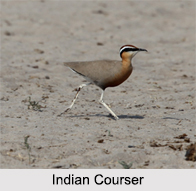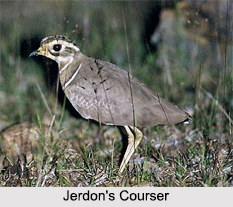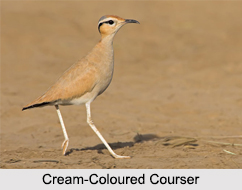 The Indian Subcontinent provides suitable habitats to various species of birds for residing and nesting. Coursers are no exception in this regard. There are about 8 species of coursers which are known to exist worldwide, out of which Indian Courser, Cream-Coloured Courser and Jerdon`s Courser occur in India. They belong to the kingdom, Animalia; phylum, Chordata; class, Aves; order, Charadriiformes; and family, Glareolidae. Some of these coursers are described below.
The Indian Subcontinent provides suitable habitats to various species of birds for residing and nesting. Coursers are no exception in this regard. There are about 8 species of coursers which are known to exist worldwide, out of which Indian Courser, Cream-Coloured Courser and Jerdon`s Courser occur in India. They belong to the kingdom, Animalia; phylum, Chordata; class, Aves; order, Charadriiformes; and family, Glareolidae. Some of these coursers are described below.
Indian Courser
The species name of Indian Courser is C. coromandelicus. This name has been derived from the drier zone on the east coast, that is, the Coromandel region. This courser has commonly been recorded in Deccan plateau and the arid regions of northwestern India in Rajasthan and Gujarat. The bird has chestnut colored crown. There is a black eye-stripe that begins at the base of the beak. The breast of the bird is rufous in appearance. In flight, the rump appears white and the wing tip is not as contrastingly black as in the cream-coloured courser. The bird has whitish long legs. As in case of other coursers, Indian Coursers have only three forward pointing toes. Male and female Indian Coursers are known to be similar. This courser depends on insects mainly termites, beetles, crickets and grasshoppers picked up from the ground in stubbly or uncultivated fields for survival.
The bird has chestnut colored crown. There is a black eye-stripe that begins at the base of the beak. The breast of the bird is rufous in appearance. In flight, the rump appears white and the wing tip is not as contrastingly black as in the cream-coloured courser. The bird has whitish long legs. As in case of other coursers, Indian Coursers have only three forward pointing toes. Male and female Indian Coursers are known to be similar. This courser depends on insects mainly termites, beetles, crickets and grasshoppers picked up from the ground in stubbly or uncultivated fields for survival.
Jerdon`s Courser
The species name of Jerdon`s Courser is R. bitorquatus. It is a grey-brown bird with a restricted-range. These critically endangered birds are endemic to the Eastern Ghats of Andhra Pradesh and extreme southern Maharashtra in India. Its bill is black with a yellow base. This bird has a blackish crown. There is a narrow white crown stripe running on top of the head. The supercilium of a bird is buff. Its throat patch is orange-chestnut in appearance. The bird has two distinctive white breast-bands bordered with black.  The bird has prominent white wingbar. There is a white patch near the tip of outermost black primaries. Male and female Jerdon`s Coursers are known to be similar. Hunting or trapping of the bird is prohibited in India.
The bird has prominent white wingbar. There is a white patch near the tip of outermost black primaries. Male and female Jerdon`s Coursers are known to be similar. Hunting or trapping of the bird is prohibited in India.
Cream-Coloured Courser
The species name of Cream-Coloured Courser is C. cursor. It is a scarce winter visitor and resident of India. This courser is a sandy colored bird which changes to whitish on the lower belly. The bird has a grey colored crown and nape. The supercilium of the bird is white in appearance. The bird has a black eye-stripe. The upperwing, primary feathers and underwings are black. It has long legs and wings. The bill of the bird is slightly curved downwards.



















